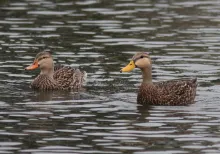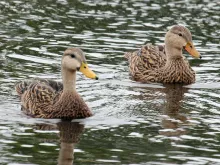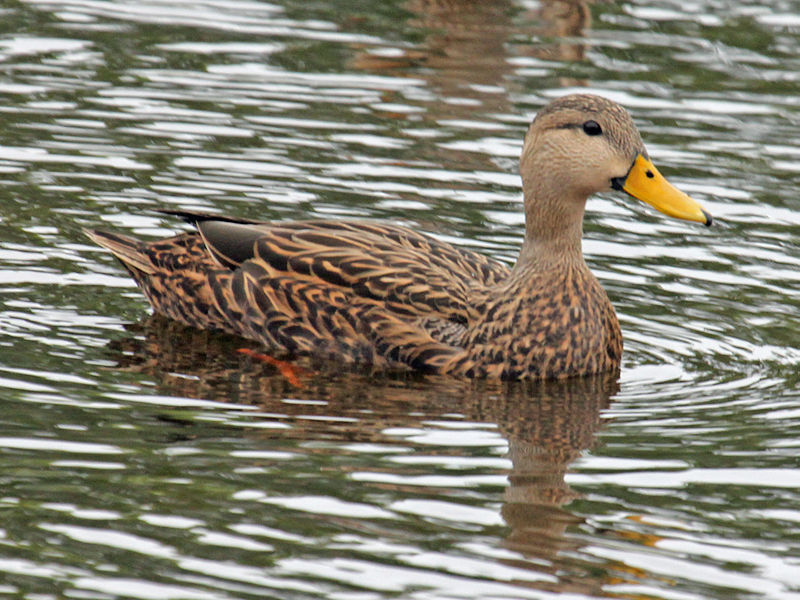
Mottled duck (Anas fulvigula)
Species name
- Dutch name:
- Gevlekte florida eend
- English name:
- Mottled Duck
- German name:
- Floridaente
- French name:
- Canard brun
- Scientific name:
- Anas fulvigula
Scientific classification
- Order:
- Anseriformes
- Family:
- Anatidae
- Onderfamilie:
- Anatinae
- Genus:
- Anas
Description
- Description:
Florida Mottled Duck (Anas fulvigula fulvigula)
Male:
The male Florida Mottled duck is light dusky brown on crown and nape; light faded eye stripe, paler grey-buff and rest of head and neck, sometimes appearing pinkish-buff on cheeks and throat. Whole of upperparts and underparts warm brown, boldly marked with V’s formed by sup terminal bands on feathers, which edged buff; markings strongest along flanks and smaller and paler on the belly and towards rear. Tertails dark brown and only thinly edged paler. Speculum bluish–teal, bordered with brown in front and black to rear, with white on tips of secondaries either very small or absent ,and outer wing dark brown, with converts similar but with paler tips; underwing very pale, almost white, with darker primaries and secondaries, though some primary converts pale grey. Bill bright yellow, with black nail, nostrils and round base, plus quite obvious spot at very base of upper mandible. Legs and feet orange.Female:
Paler and more streaked on underparts through broader edgings to feathers. Bill dull orange-yellow with black olive spots, these are concentrated in middle of upper mandible; legs and feet orange.Juvenile:
Duller brown, less well marked on underparts, particularly flanks, and darker on upperparts, with smaller pale feather edgings. Feet and legs light yellowish orange.Gulf Coast Mottled Duck (Anas fulvigula maculosa)
Male:
Over all having Shorter neck and being Darker with a reddish tan hue to the plumage.Dark Dusky Brown on crown and nape; light faded eye stripe, paler grey-buff and rest of head and neck, sometimes appearing buff on cheeks and throat. Whole of upperparts and underparts warm brown, boldly Dark black marked with V’s formed by sup terminal bands on feathers, which edged buff; markings strongest along flanks and smaller and paler on the belly and towards rear. Tertails dark brown and only thinly edged paler. Speculum bluish–teal ,bordered with brown in front and black to rear, with white to secondaries either very small or absent ,and outer wing dark brown, with converts similar but with paler tips; underwing very pale, almost white, with darker primaries and secondaries, though some primary converts pale grey. Bill Strong bright yellow, with black nail, nostrils and round base, plus quite obvious spot at very base of upper mandible. Legs and Feet orange .Female:
Paler and more streaked on underparts through broader edgings to feathers. Bill dull orange-yellow with black olive spots, these are concentrated in middle of upper mandible; legs and feet orange.Juvenile:
Duller brown, less well marked on underparts, particularly flanks, and darker on upperparts, with smaller pale feather edgings. Feet and legs light yellowish orange.
- Behaviour:
Usually found as pairs, with small flocks during the moult. Pairs formed in early winter and remain together for most of the year, except in the moult after breeding.
Standard Measurements
- Body Length (cm):
- The male (drake) of the Mottled duck measures approximately 53-58 centimeters. The female measures approximately 53-58 centimeters.
- Body Weight (grams):
- The male will weight about 1030 gram. The female will weight about 970 gram.
The weight is notoriously variable and can only be used as indication!
- Subspecies:
There are two subspecies:
- Florida Mottled Duck - Anas fulvigula fulvigula
- Gulf Coast Mottled Duck - Anas fulvigula maculosa
- Note:
Dabbling Ducks are generally hardy, easy to maintain and easy to breed. Shelter may be required by some of the smaller species in winter. They should be provided with cover (including marginal pond cover) and loafing areas as well as water. A pen which is 50% water is suggested. The water may be shallow (i.e. no more than two feet deep is required), and muddy areas for dabbling in are also appreciated. These ducks are generally good in mixed collections, although the smaller and quieter species may be bullied. Territorial disputes between ducks of the same species may be avoided by keeping only one pair of each species in an enclosure, unless the area is very large. For a single pair of ducks a pen are of 50 to 100 square metres, depending on the size of duck, should be provided.
A diet based on wheat and pellets is suggested, with maintenance pellets changed to breeders pellets for the breeding season. Bread and greenfood are also appreciated. Grit should always be available, with soluble grit (e.g. oystershell grit) as a calcium source when breeding.
Most species are ground nesters and both close ground cover and ground level nest boxes should be provided. Hand-rearing is generally preferred, as these ducks are generally poor parents in captive conditions, particularly in enclosures shared with other waterfowl. These ducks are prone to hybridization, particularly with closely related species, which should be kept apart from one another.
Mottled ducks (Florida ducks) are easy to manage and suitable for mixed collections; water, loafing areas and cover should all be provided.
These ducks breed regularly in captivity. Close natural cover and ground-level nest boxes should be provided for nesting; more open cover may also be used.
They should be kept separate from closely-related types (other mallard-type ducks) to avoid hybridisation.
- Breeding:
- The female Mottled duck usually lays from 6-12 creamy to greenish-white eggs and incubates them for 26-28 days.
- Artificial incubating:
The ideal relative humidity for incubating most waterfowl eggs is 55% (ground nesters) and 40% (cavity nesters). The temperature is usually 37.4°C. Set ventilation as recommended by the incubator manufacturer. Eggs must be turned, either automatically or by hand, a minimum of 4 times a day. As the duckling develops there is a loss of water from the egg and the air sac gets bigger. In normal development of an egg with a 26-28 days incubation, the air sac occupies about a third of it three days earlier. Cleanliness is vital and ideally eggs should be moved to a separate hatcher at this point, where the humidity should be increased to 65% and even higher once they have pipped internally.
- Bird banding:
- Recommended closed leg band ring size for the Mottled duck is 11 mm.The leg band ring can only be applied on a young dabbling duck at around 12 days old.
- It doesn't matter what leg that you band, but it's good to have a consistent system. Suggested: Left leg = Female, Right leg = Male
- Maintenance food:
-



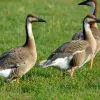

Lundi Regular with a protein content of 20%, valuable Spirulina and high-quality by-products is optimally balanced in its composition maintenance food for water ornamental fowl of all kinds. Especially green teal and Whistling ducks that are not dependent on a very high protein content, are well supplied.
Lundi Regular contains all the minerals and vitamins in full form that are important for the animals. Therefore also suitable as breeding food.


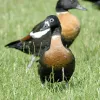


Floating full food for all sea ducks, green ducks, eider ducks and geese, especially in the moulting and breeding phase ideally suited. Packed with wholesome raw materials, natural vitamins and trace elements, this performance food with a protein content of 30% forms the basis for lifelong vitality.
